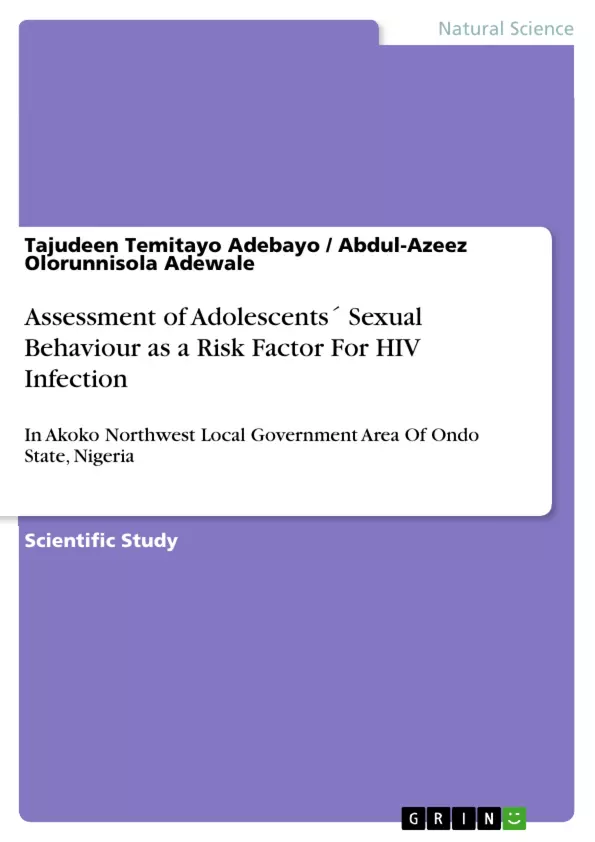The study examines assessment of adolescents’ sexual behaviour as a risk factor for hiv infection in akoko northwest local government area of Ondo state. The descriptive survey design was used for the study. A study sample of 378 adolescents in Akoko Northwest Local Government Area of Ondo State were randomly selected using the multi-stage random sampling technique. Primary data was collected and gathered with the aid of structured, self-administered questionnaire.Clarity of questions was tested by first conducting a pilot study Statistic. Retrieval of instrument from respondents was immediate yielding a 100% return rate. SPSS was then combined with EPI Info to make a comprehensive result that was outlined in the results section. Descriptive statistics such as frequencies and percentage distribution was used to show the distribution of the study population according to selected study variables.
There is no evidence of association between adolescents’ gender, class, and ethnicity while there is an association between adolescents’ age, religion and adolescent sexual behaviour. That majority of the adolescents were aware of HIV, Majority of the adolescents were aware of HIV/AIDS via peer group, Major prevalent risky sexual behaviours among adolescents is virginal sex, Majority of the respondent had their first sex at age 11-13 years, Majority of the respondent had never used condom.There is significant association between the level of awareness of HIV/AIDS and prevalent risky sexual behaviours of the adolescent. Based on the findings of this study one can candidly conclude that Major prevalent risky sexual behaviours among adolescents is virginal sex. That majority of the adolescents were aware of HIV. Majority of the adolescents were aware of HIV/AIDS via peer group. That majority of the adolescents were aware of HIV and mostly through friends/peer group. Majority of the respondent had their first sex at age 11-13 years, Majority of the respondent had never used condom.And that there is significant association between the level of awareness of HIV/AIDS and prevalence of risky sexual behaviours of the adolescents.
There is need to introduce HIV Voluntary Counseling and Testing services in schools through the School and Adolescent Health Programmes, while more attention should be given to proper implementation of the existing programs that reduce stigma, and inculcate a more positive attitude to People Living with HIV/AIDS.
Inhaltsverzeichnis (Table of Contents)
- ABSTRACT
- DEDICATION
- CHAPTER ONE
- Introduction
- Statement of the Problem
- Objectives of the Study
- Research Questions
- Hypothesis
- Significance of the Study
- Scope of the Study
- Limitation of the Study
- Definition of Terms
- CHAPTER TWO
- Literature Review
- Conceptual Framework
- Theoretical Framework
- CHAPTER THREE
- Research Methodology
- Research Design
- Population of the Study
- Sample and Sampling Technique
- Instrument for Data Collection
- Validity and Reliability of the Instrument
- Method of Data Collection
- Method of Data Analysis
- CHAPTER FOUR
- Presentation and Analysis of Data
- CHAPTER FIVE
- Discussion of Findings
- Summary of Findings
- Conclusion
- Recommendations
- REFERENCES
- APPENDIX
Zielsetzung und Themenschwerpunkte (Objectives and Key Themes)
This research project aims to evaluate the link between adolescents' sexual behavior and the risk of HIV infection in the Akoko Northwest Local Government Area of Ondo State, Nigeria. The study utilizes a descriptive survey design to analyze data collected from a sample of adolescents within the region.
- The prevalence of risky sexual behaviors among adolescents in the study area.
- The relationship between adolescents' awareness of HIV/AIDS and their engagement in risky sexual practices.
- The influence of sociodemographic factors such as age, gender, religion, and ethnicity on adolescent sexual behavior.
- The identification of potential interventions to mitigate the risk of HIV infection among adolescents in the region.
- The importance of comprehensive sexual and reproductive health education for adolescents.
Zusammenfassung der Kapitel (Chapter Summaries)
- Chapter One: Introduction This chapter sets the stage for the study by introducing the background, problem statement, objectives, research questions, hypothesis, significance, scope, limitations, and definition of key terms. It provides a comprehensive overview of the study's rationale and framework.
- Chapter Two: Literature Review This chapter explores existing literature related to adolescent sexual behavior and HIV/AIDS, focusing on the context of Nigeria. It examines previous studies, theoretical frameworks, and conceptual models that provide insights into the research topic.
- Chapter Three: Research Methodology This chapter outlines the research design, population, sample, sampling technique, data collection methods, and data analysis strategies used in the study. It describes the procedures employed to ensure the validity and reliability of the research process.
- Chapter Four: Presentation and Analysis of Data This chapter presents the findings of the study in a clear and organized manner. It utilizes tables, graphs, and statistical analyses to illustrate the key results obtained from the data collected.
Schlüsselwörter (Keywords)
This research focuses on the assessment of adolescent sexual behavior, HIV risk factors, and the impact of awareness on sexual practices. Key terms include: adolescent sexual behavior, HIV infection, risky sexual behavior, awareness, prevention, intervention, and sexual and reproductive health education.
- Citar trabajo
- Tajudeen Temitayo Adebayo (Autor), Abdul-Azeez Olorunnisola Adewale (Autor), 2019, Assessment of Adolescents´ Sexual Behaviour as a Risk Factor For HIV Infection, Múnich, GRIN Verlag, https://www.grin.com/document/467893



